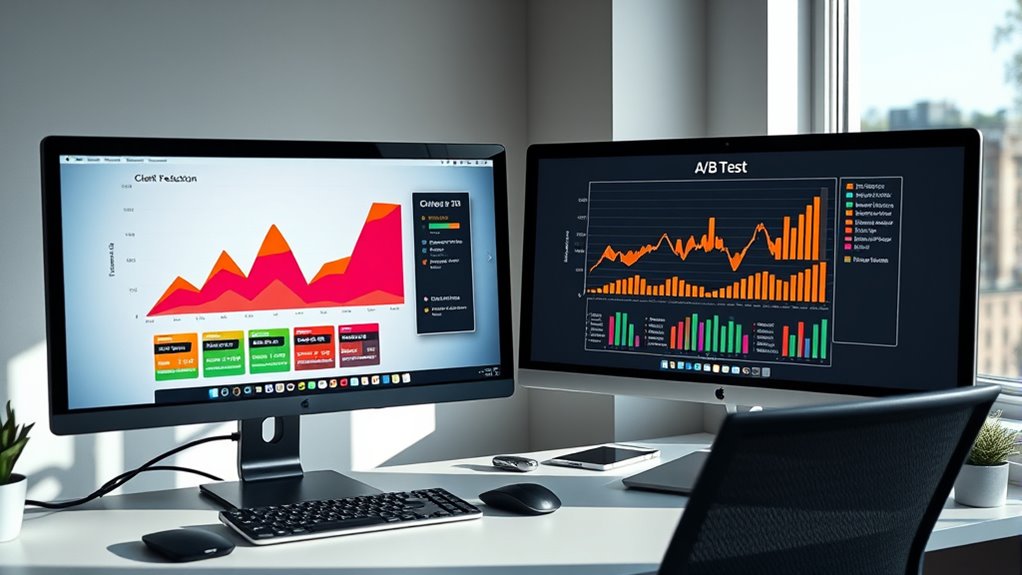To avoid external factors skewing your A/B test results, control for variables like traffic sources and testing during stable periods. Segment traffic by source or run tests within consistent pools to eliminate biases. Schedule tests outside peak seasons or during steady conditions to reduce external influences. Monitoring traffic patterns helps catch anomalies early. If you want to refine your approach further, you’ll discover valuable strategies to guarantee your tests remain reliable.
Key Takeaways
- Segment traffic by source to minimize variability and isolate test effects.
- Schedule tests during stable periods, avoiding seasonal or promotional fluctuations.
- Monitor and control external campaigns that could influence user behavior during testing.
- Ensure consistent traffic sources across test groups to prevent skewed results.
- Use statistical power calculations to determine adequate sample size, reducing the impact of external noise.

A/B testing can provide valuable insights into optimizing your website or product, but external factors often threaten its accuracy. To get reliable results, you need to control variables that could skew your data, especially when it comes to sample size and traffic sources. If your sample size is too small, your test results might not reflect true user preferences, leading to false positives or negatives. A small sample can cause fluctuations that seem significant but are actually just random noise. Hence, it’s essential to determine an appropriate sample size before launching your test. Relying on inadequate sample sizes can cause you to draw conclusions from unrepresentative data, wasting time and resources. Using statistical power calculations can help you decide how many visitors you need to include to detect meaningful differences confidently. Additionally, understanding the emotional support needs of your users can help interpret unexpected results and improve your testing approach.
Ensure your sample size is sufficient to obtain accurate, reliable A/B test results.
Traffic sources are another external factor that can distort your A/B test outcomes. If your visitors come from different sources—such as organic search, paid ads, social media, or email campaigns—they may behave differently, which can influence your test results. For example, users arriving via paid campaigns might have different intent or engagement levels compared to organic visitors. If you don’t account for these differences, you risk attributing performance changes to your test variables rather than the underlying traffic quality. To mitigate this, segment your traffic by source or ensure you’re testing within a consistent traffic pool. Keep traffic sources stable during the test period or run separate tests for different segments to identify genuine effects.
External factors like seasonal trends, promotional campaigns, or even day-of-the-week effects can also impact your results. These influences may lead to variations in user behavior that aren’t related to your test elements. To reduce this risk, schedule your tests during periods of typical activity and avoid running multiple campaigns simultaneously. Additionally, monitor your traffic patterns and conversion rates regularly to identify anomalies that could indicate external disruptions.
Making sure that your traffic sources are consistent and your sample size is adequate helps isolate the true impact of the changes you’re testing. By controlling these external variables, you improve your chances of making data-driven decisions with confidence. Ultimately, understanding and managing external factors empowers you to trust your A/B test results, leading to more effective optimizations and better user experiences.
Frequently Asked Questions
How Can Seasonal Trends Impact A/B Test Outcomes?
Seasonal fluctuations and holiday effects can markedly impact your A/B test outcomes by causing variations in user behavior during specific times of the year. When you don’t account for these, you might mistake seasonal changes for genuine differences between your test variants. To avoid skewed results, run tests over multiple seasons or compare data across similar periods, ensuring that seasonal trends don’t distort your insights.
What Role Does User Device Variability Play in Test Results?
Device diversity and user agents markedly impact your A/B test results. Different devices, like smartphones, tablets, and desktops, may display your website differently, influencing user interactions. Variations in user agents can also affect how your site loads and functions. To guarantee accurate results, you need to track and analyze how these factors influence user behavior across diverse devices, then optimize your tests accordingly for consistent, reliable insights.
How Does Geographic Location Influence External Factors in Testing?
Geographic location influences external factors through regional behavior and cultural differences, which can affect how users interact with your test. You might see varied responses based on local holidays, language preferences, or regional trends. To get accurate results, segment your data by location, tailor your messaging to cultural nuances, and consider regional behaviors. This helps make sure your test reflects true user preferences rather than external, location-based influences.
Can Competitor Activities Affect A/B Test Integrity?
Competitor activities can profoundly impact your A/B test integrity, especially in a market saturated with noise. When they launch influencer collaborations or aggressive marketing pushes, they can skew user behavior and traffic patterns, making your results unreliable. You need to monitor these external moves closely, as they can create a ripple effect, turning your test into a chaotic battlefield where true insights get lost in the chaos.
How Should External Marketing Campaigns Be Timed With Testing Periods?
You should synchronize your external marketing campaigns with your testing periods through campaign synchronization, ensuring they don’t run simultaneously with your tests. Timing optimization involves scheduling campaigns during stable periods when test results are less likely to be impacted by external influences. By carefully aligning campaign launches and test windows, you minimize external effects, maintaining the integrity of your A/B test results and gaining clearer insights into your strategies’ true performance.
Conclusion
To guarantee your A/B test results are accurate, always control external factors. For example, if you’re testing a new landing page, run tests during similar times and days to avoid traffic fluctuations. In one case, a retailer saw skewed results because of a holiday sale overlapping with the test. By scheduling tests carefully, you can confidently determine what truly impacts user behavior and make informed decisions without external noise influencing your data.









